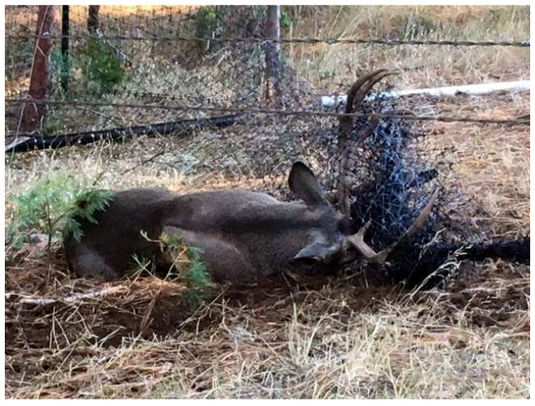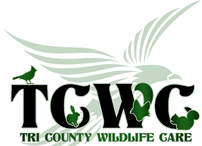Netting it Out

Photo posted on Facebook by the California Department of Fish & Wildlife on December 6, 2017 with the following caption: “Good deed of the week: Nathan Graveline, a CDFW wildlife biologist in our Central Region, received a call Monday about a deer tangled up in some nylon netting at an apple orchard in Tuolumne County. When Nathan arrived at the scene, he found the antlers of a rather large buck hopelessly entangled in the netting with no way for the deer to free itself. Nathan intervened. He was able to sedate the buck, cut the netting and free the deer. Well done Nathan!”
We humans take great pride in our gardens, from potted succulents on the porch, to multi-acre orchards. We can control many aspects of gardening (like water, fertilizer, and soil amendments), but we have a much harder time controlling wildlife. Wildlife provide plenty of garden benefits, like insect control, pollination, and soil aeration. However, they may also help themselves to your spring veggies, apples, or berries. There are some safe ways that we can share the outdoors with our wild neighbors.
One common method is to use netting to block birds from trees and bushes. Netting can be effective, but can be fatal to animals if applied improperly. The holes in the netting should be so small that you can’t poke your finger through. Holes that are larger than that are easy for birds, bats, and reptiles to get tangled in and they could be strangled. Netting also needs to be properly fitted and attached to the plant. It needs to be checked daily for trapped animals and you will probably have to cut the netting to release the animal. You should take the netting material into consideration too. Thin monofilament netting is one of the most dangerous types for wildlife. While animal-safe netting has become an issue in Australia, it hasn’t picked up much steam here yet. Upon investigation, the closest product that I have found is Avigard Hex Net, available online from www.plantra.com. While this brand is still made of plastic materials, it is thicker and, theoretically, safer than monofilament netting. Be sure to do the “finger test” by trying to poke your fingers through any netting that you find in a store, and if you can pass a finger through, it probably isn’t wildlife safe. Side note, we have found that “bird safe netting” often shades the plants more than is desired.
Another method to safely deter wildlife is to use a scarecrow. You can easily make a scarecrow from some old clothing and wooden stakes or sticks. It doesn’t need to look realistically human, but you should move it around every few days. You can use metal pie pans and specially designed metallic garden ribbons to scare birds away too. Some people even put out fake rubber snakes to scare away birds.
If blocking and scaring animals isn’t your style, you can compromise and offer them their own “sacrificial” plants. Planting native species has many benefits, including serving as a food source to native wildlife. You can also offer an extra berry bush or a couple of sunflowers a short distance away from your prized crops.
Regardless of the method you choose to coexist with our wild neighbors, do it responsibly and safely. Be mindful of chemical applications. Birds, frogs, and lizards do a great job taking care of bugs, so insecticides may be unnecessary. Herbicides and excess fertilizer can do more harm than good, especially if it runs off into creeks or rivers. Take a break from your hard work and enjoy observing your visitors. You may come up with more ideas just by identifying them and studying their habits.
For more information and ideas:
Wildlife and Netting: http://www.wildlifefriendlyfencing.com/WFF/Netting.html
Keeping birds out: http://www.diynatural.com/how-to-keep-birds-out-of-garden

